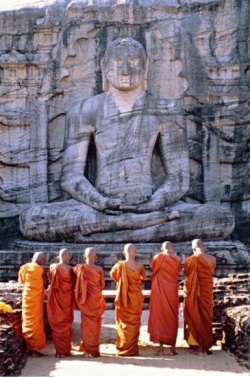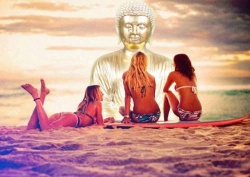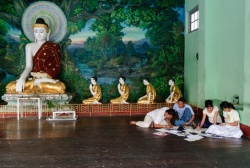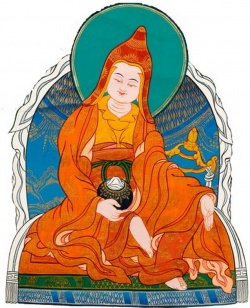The Realm of Awakening: Chapter Ten of Asanga's Mahayanasangraha
This important text of the Buddhist master Asanga has been known to Western scholarship for some time by the French translation by Etienne Lamotte: La Somme du Grand Vehicule d'Asanga (Mahayanasamgraha), 2 vols. (Louvain, 1938-39).
Lamotte for his translation and commentary utilized the Tibetan translation and canonical commentaries, the four complete or partial Chinese translations and the Hsuan-tsang Chinese Vasubandhu commentary, and gave parallel passages in the Sanskrit editions of the Mahayanasutralamkara and the Bodhisattvabhumi.
After one scholar did so much, the reader may wonder why it takes four plus three scholars to study the tenth and last chapter of the same work.
Naturally, these authors will respond that they have studied this chapter in depth.
That is to say, they have completely translated the Chinese versions of Paramartha and Hsuan-tsang, rendering Vasubandhu's commentary (the Bhasya);
and from Tibetan have translated Vasubandhu's commentary (although a large part of it is missing) and the entire Asvabhava commentary (the Upanibandhana).
Besides, Asanga's Abhidharmasamuccaya and its commentary were both cited from the Sanskrit editions.
Thus, these authors can insist that they were severally trained in the various essential languages, and so could study the chapter thoroughly.
For the texts utilized, the Sanskrit and the Tibetan are presented in transcriptions in the section "Texts".
The authors do not present the Chinese "for technical reasons" (not given), but give text references to the Japanese edition of the Chinese Buddhist canon.
Of course, the Indian commentaries were meant to explain the basic text, make it more comprehensible.
Therefore, the reviewer will test the book on a few of Asanga's verses to see if the authors have advanced over Lamotte's work and have adequate control of the Tibetan.
It should be mentioned that Lamotte employed a sensible system of numbering (in chapter ten) of bold arabic numerals and a group of less bold and smaller arabic numerals.
Our authors adopted an awkward system using alphabetic letters and frequently a symbol, that is not on standard keyboards.
Therefore, I shall refer only to page numbers.
Our authors translate an Asanga verse at pages 54 and 190: "At times, like a fire, Buddha manifests perfect awakening, and at times, like a fire, he is extinguished.
But the body of the Tathagatas is never non-existent."
The translation agrees with Lamotte (II: 310-11), where for the "at times" there is Fr. tantot.
However, Lamotte (Tibetan text, I: 91), shows Tib. la lar, which is equivalent to Skt. kvacit, usually locative, but sometimes temporal, especially in the negation ("never").
But Lamotte (II: 311, note) cites the parallel verse of Sutralamkara, IX.17, first line, reading: yathagnir jvalate 'nyatra punar anyatra samyati, where anyatra shows the locative suffix.
It follows that the verse was misrendered.
It should go: "Like fire, somewhere (the Buddha) manifests perfect awakening, and somewhere is extinguished (in nirvana).
The body of the Tathagatas is never non-existent (somewhere)."
Our authors translate a verse at pages 54 and 187: "The victor, whose actions completely interpenetrate, just like water in the ocean, has no intention of benefiting others by thinking 'I have done, am doing, or will do |such-and-such~'."
Lamotte (II:309-19) was slightly better; he agrees on the "actions" (karman), but makes a plural (in agreement with the Tibetan) "des Buddha," and the actions are "homegenes" (his suggested Skt. samsrsta probably correct) and are compared with the plural "waters" (Fr. aux eaux), in agreement with the commentaries.
The Tibetan version, Lamotte (I:91), gives the honorific form of "actions" (phrin las can) suggesting "wondrous actions."
Hence, my version: "The victors have wondrous actions that completely mix |with the sentient realm~ like |river~ waters in the ocean.
There is no intention of others' aim with |ordinary~ thoughts, 'I have done, am doing, will do'."
As a result of my findings in these two tests, and other observations, I conclude that the Tibetan texts were not independent evidence for these authors.
I suppose that their main expertise was in the Sino-Japanese field and that the control of Sanskrit was adequate.
Therefore, it is a pity that they did not provide the Chinese for those passages they translated, rather than the Tibetan.
In short, when they claim to be translating from Tibetan, they probably rely on the Chinese, namely, the Hsuan-tsang versions, to help in interpreting the Tibetan.
Among their Sino-Japanese utilizations is the Japanese version of Asanga's text.
In their bibliography they list under NAGAO, "(trs.) Shodaijoron wayaku to chukai. Tokyo: Kodansha, 1982, 1987."
For the "trs." the entry should have read: "and ARAMAKI Noritoshi (trs.)."
And an example from the annotation to the translations.
Here, Asanga's verse is rendered: "You behold the entire world six times each day and night."
The note claims unabashedly: "That is, always. A reference to the standard Indian division of the twenty-four hours into six equal periods."
If the guess were correct, why didn't Asanga write: "You behold the entire world throughout the day and night"? See the book which Lessing and this reviewer translated:
"In the six times of day and night he must give thought to the benefits of taking refuge and generating the Mind."
(1) The information is given (see in the index under "Watch"), esp. pp. 191-95, where five of them are precisely described, but on p. 152, note, they are explained as the four sandhis, dusk, dawn, noon and midnight; plus another 'watch' or 'session' in mid-morning, another one between dusk and midnight.
Now it is necessary to remark upon John Keenan's introduction.
The writer purports to explain the Yogacara "hermeneutic."
But Keenan goes astray in important ways. He (at p. 14) accepts an historical teacher named Maitreya, "the mentor of Asanga," and in the note thereto says:
There has been much dispute on the historical status of Maitreya as he is presented in the traditional accounts.
We do not wish to enter into that discussion here, and by using the name 'Maitreya' we are simply referring to the author of those texts which are clearly earlier than Asanga and which influenced him."
Accordingly Keenan mentions the name Maitreya in subsequent pages and as an historical author.
In fact, to the Buddhists of China and Tibet the name Maitreya meant the future Buddha Maitreya dwelling in a heaven called Tusita.
The biographies of Vasubandhu claimed that Asanga, by yoga power, ascended to this heaven and was instructed by Maitreya, indeed, brought down from this heaven several scriptures.
The oldest biography of Vasubandhu presenting this story is that of Paramartha, a biography translated by the Japanese scholar Takakusu,
(2) which is not entered in the bibliography of the book under review. Originally, these Vasubandhu biographies and Yogacara works that deal with the topic, included under this Maitreya inspiration the plan of the seventeen bhumis of Asanga's Yogacarabhumi,
as well as the treatises Mahayanasutralamkara and Madhyantavibhaga.
Later, as in Tibet, the set of inspired treatises was increased to five members. Hence, Keenan's use of Maitreya as an historical teacher amounts to fake literary history.
Starting p. 14, Keenan attempts to uncover what he refers to as the "dialectic" of Asanga's MS, tenth chapter.
He begins by discussing Sthiramati's commentary on the Madhyantavibhaga, IV.16. On p. 15, he makes a heading, "A False Reading of Sthiramati."
Now, who knows the topic better--Sthiramati or Keenan?
Keenan tried to squeeze from Sthiramati's commentary a variant theory of Dharmakaya excluding wisdom.
The reviewer does not quarrel with Keenan's translation of Sthiramati's comment, which appears well done.
It is just that Keenan did not realize that the real issue faced by Sthiramati was whether the Dharmakaya is generated by merit, or is somewhere to be reached but not generated.
His first comment is of course on the Madhyantavibhaga; and here the position is that it is generated by merit, namely by eliminating all obstacles, substituting pure dharma-seeds, one has a 'transformation of the basis' and gains control over all dharmas.
Then he presents two theories of other scriptures or texts that regard the Dharmakaya as something to be reached.
The first of these accepts the Dharmakaya as a body equivalent to the pure Realm of Dharmas (dharmadhatu), free from adventitious defilements.
The second kind of text accepts the Dharmakaya as supernal wisdom (jnana) regarding all the knowable (jneya) while being unattached to it. Sthiramati's comments here are brilliant.
Finally, the reviewer acknowledges that the team of scholars carefully presented in translation these materials, especially from Chinese.
If Keenan had left out most of what he put in the introduction, and instead had dwelt on the extent to which the study of the commentaries had clarified Asanga's basic verses of the Mahayanasamgraha, the reviewer would have been happy to report this.
1 Mkhas Grub Rje's Fundamentals of the Buddhist Tantras, translated from the Tibetan by Ferdinand D. Lessing and Alex Wayman (The Hague: Mouton, 1968; 2d ed., Dehli: Motilal Banarsidass, 1978), 153.
2 J. Takakusu, "The Life of Vasubandhu by Paramartha (A.D. 499-569)," T'oung Pao II.5:269-96.





